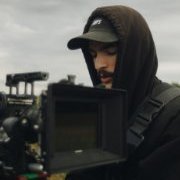-
Posts
13,756 -
Joined
-
Last visited
About Phil Rhodes

Profile Information
-
Occupation
Other
-
Location
London
Contact Methods
-
Website URL
http://
Recent Profile Visitors
-

The influence of video game style on filmmaking
Phil Rhodes replied to Jon O'Brien's topic in General Discussion
To a great extent it's likely a learned response to the zeitgeist. That said, any sort of moving camera inherently encodes three-dimensional information into a fundamentally two-dimensional medium, so there's possibly some argument for the general use of camera motion. -
I think the better question is whether film cameras actually need to have particularly high-precision pulldown in 2024. Everything's going to be electronically stabilised anyway - witness the results people are getting even out of Super-8 these days. Get the image on the film somehow. Where barely matters, within sane limits.
-
I'd love to see how you've retrofitted it with LEDs. Is that something you can go into more detail about? There seems to be a pretty healthy appetite for film handling services which is good to see.
- 13 replies
-
- color grade
-
(and 1 more)
Tagged with:
-

High quality individually addressable LEDs?
Phil Rhodes replied to Teddy Young's topic in Lighting for Film & Video
Not that I know of. All the addressable LEDs I'm aware of, things like the WS2812, are RGB-only devices. They also use pulse width modulation at a rate which is likely to cause flicker problems. It's not impossible to think that someone has made something better but I'm not aware of it. You certainly can get individual emitter devices which have RGBW clusters on them. I'm not sure if any of those have a particularly great white emitter but it's possible that with some careful mixing you could end up with something reasonable, I'm not sure. You could also spin your own by clustering the smallest-available surface mount LEDs on a tiny PCB. It wouldn't be as small as a WS2812, but depending what you need it might work I'm not sure what options there are for tiny driver chips but at least that way you'd have the choice of emitter types and drive electronics. All of that assumes you've googled extensively for a high colour quality device that's available off the shelf. As I say I've not come across one but there's a lot of stuff out there. P -
That's a Mole junior rolling stand, or something very like it. I own two very old ones. I'm not sure if they're still in manufacture. More a TV studio thing, I think, but you should be able to find some.
- 11 replies
-
- 1
-

-
- lights
- light stand
-
(and 3 more)
Tagged with:
-
What is this"grip truck" of which you speak... But seriously, I wandered into Filmtools here in LA this week where they had one on display, and the number appears to be twelve inches.
-
Oliver Suckling started following Phil Rhodes
-
I'm after something on that order, something that can replace a rideable dolly in at least some circumstances. I guess it doesn't make that much difference, really. Ten or twelve inches was my inclination. Saw a rather nice one at NAB with the motor drive system.
-
Thanks - though I don't know what the standard is...
-
Hello! Is there anything like a standard for the spacing on miniature slider dolly track? I'm thinking things like this: I'm sort of work-in-progress here. I have parts that would permit 9", a hair less than 230mm, which... looks reasonable, I guess? The tube will be 35mm on the basis that's what the clamps handle. P
-
I don't really know enough about this to comment, but I would like to ask questions about the working relationship between the armourer and the senior crew, particularly the first assistant director. I have other questions about her qualifications and how they interact with family relationships as a common and expected route to advancement in the film industry. I suspect people other than this armourer have questions to answer but I would be interested to know how such an accident could take place without her having made large mistakes.
-
Do you have another cable or other device that can power the light? If so, measure its output with a multimeter. It's very common for the centre pin of those DC connectors to be positive, and I would expect the shield (also called the screen in English) to be used as the negative connector. However neither of those is guaranteed and you should not make assumptions. If you don't have another power cable with which to compare, maybe just ask Dedolight for the information.
-

How was this hall lit? (Blue Jean, 2022)
Phil Rhodes replied to Aidan Brook's topic in Lighting for Film & Video
Hate to say it but to me that just looks like they walked into any school sports hall on a dull, overcast day and shot it under available light. Possibly it's something to do with the fact that my earliest memories are of environments like that.- 2 replies
-
- 2
-

-
- lighting
- ambient light
-
(and 1 more)
Tagged with:
-
I hate to say it but absolutely nothing in that transcript surprises me one iota.












